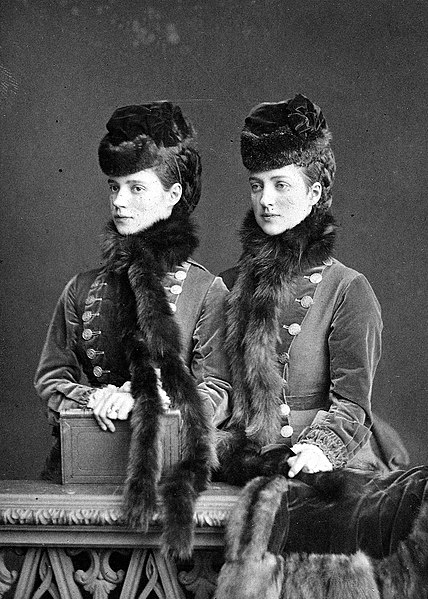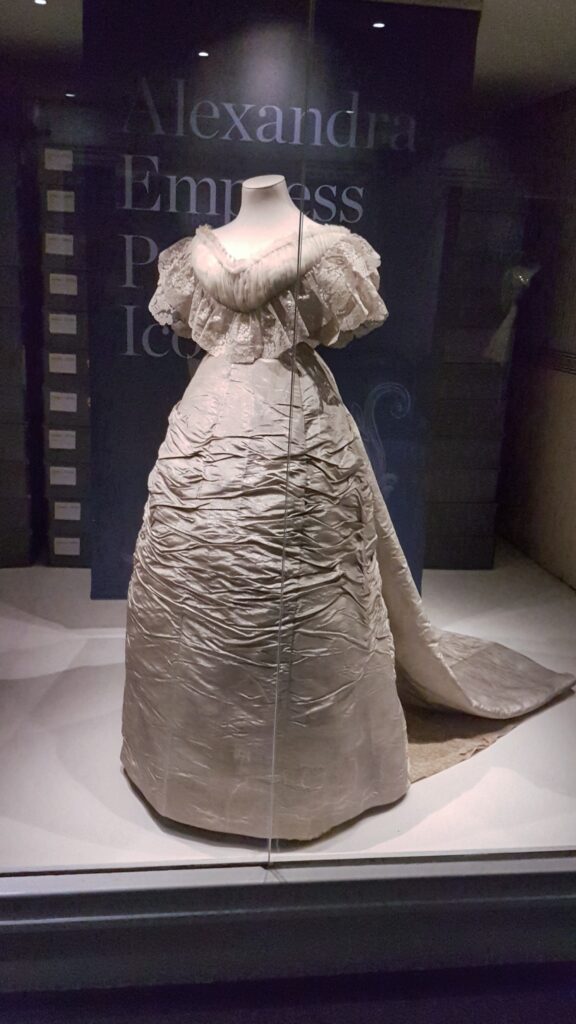Royal fashion is still a popular topic today, with RepliKates and Mirror-Megs immediately selling out on the spot. And with the late Princess of Wales’ wedding dress about to go on display, it is obvious that royal wedding dresses are pieces of history. We continue our Fashion Favourites series with the trendsetting Princess (and later Queen) Alexandra of Denmark, who played a large role in women’s fashion for much of her marriage.
Alexandra Caroline Marie Charlotte Louise Julia of Schleswig-Holstein-Sonderburg-Glücksburg was born on 1 December 1844 at the Yellow Palace in Copenhagen. Her father, a relatively minor prince at her birth, would be King Christian IX of Denmark in 1852. The family was still relatively impoverished, and Alix, as she was known to the family, spent much of her childhood with her sister, Dagmar. (Dagmar would go on to marry the future Tsar Alexander III.) Although not Victoria and Albert’s first choice, Alexandra was chosen to marry the Prince of Wales, Bertie.
Alexandra and Bertie were introduced in September of 1861, by his sister, Crown Princess Victoria of Prussia. He didn’t propose to her until September of 1862 after his father had died. Alexandra’s wedding dress was her first taste of fashion fame.
Victoria stressed to Alexandra that her dress needed to be patriotic and highlight her new country. Unfortunately, Alexandra’s uncle, King Leopold of Belgium, had given her several yards of Brussels lace, but she wasn’t allowed to use it. Instead, she had to use British made Honiton lace for her wedding gown. (She did have one piece of the Brussels lace inside the gown, perhaps a small act of subversion.)
Unlike Empress Eugenie, Alexandra was not set on one particular designer. Like many other royal and aristocratic women of the period, she visited a number of different dressmakers to outfit her wardrobe. And despite Victoria’s push to support only British textile manufacturers and dressmakers, Alexandra frequently visited Parisian couturiers for all of her adult life.

Alexandra immediately became popular in Britain. She was young, she was beautiful, and she was fashionable. And people quickly started copying her style. Alexandra preferred a simple but striking silhouette of a well-tailored, two-piece suit for her day to day life. The tailored look took off, and in the 1870s, there was a much more defined silhouette in women’s fashion in Britain.
Alexandra didn’t initiate many trends herself, but her early adoption popularised them. The Princess-line dress was created by Charles Frederick Worth and named in honour of her streamlined silhouette. She quickly adopted the style and wore it for several years.

She also liked to wear chokers and high necked gowns. It is thought that she preferred this style to either cover a scar from a childhood surgery or perhaps a goitre. In any case, chokers remained a popular accessory for women for several decades. Alexandra also ended up with a permanent limp after contracting an unknown illness after her sixth pregnancy. Because she was so popular, women would mimic her limp and use a walking stick for fashionable rather than practical reasons.
Interestingly, Alexandra could also be very playful with her wardrobe. When she would meet with her sister, Dagmar, the two would often have entirely matching wardrobes from head to toe. The sisters remained incredibly close throughout their entire lives, and their matching ensembles were a very visual indicator.
Princess Alexandra was a royal fashion icon throughout much of her marriage. After the death of her eldest son, Prince Albert Victor, in 1892, she remained permanently in half-mourning for him. Her wardrobe consisted largely of blacks, greys, and muted purples. She continued to favour a slim, structured silhouette until her death in 1925.


